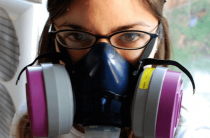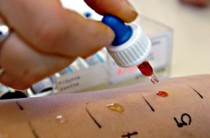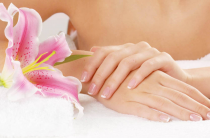Allergy is a rather severe disease. Its manifestations cause the patient to experience significant discomfort and some deprivation in everyday life. Among the main signs of allergies are cough, hives, rhinitis and conjunctivitis. Due to their structure, the eyes are very susceptible to allergic effects. They are sensitive to mold, dust, pollen, wool, cosmetics, and even some food fumes.
The symptoms of allergy in the eyes are quite diverse in their external manifestations - from slight redness to damage to the optic nerve. Having identified the nature of the allergic disease, you should choose the necessary drops for the eyes.
Types of eye allergies
Allergic eye dermatitis is very common. Such a disease appears precisely on the skin of the upper and lower eyelids. Characterized by a rash in the form of pimples and blisters, itching and burning, redness. Such an eye allergy often occurs against the background of the use of low-quality cosmetics. Often, workers in the chemical and food industries are exposed to eye dermatitis.
But allergic conjunctivitis is always accompanied by lacrimation and often there is swelling of the mucous membrane of the eye. With the beginning of the first flowering of plants, patients suffer from pollinous conjunctivitis. A feature of this disease is its seasonality and periodicity. Pollinous conjunctivitis of the eye is also accompanied by such concomitant manifestations as sneezing, coughing, nasal congestion and rash.
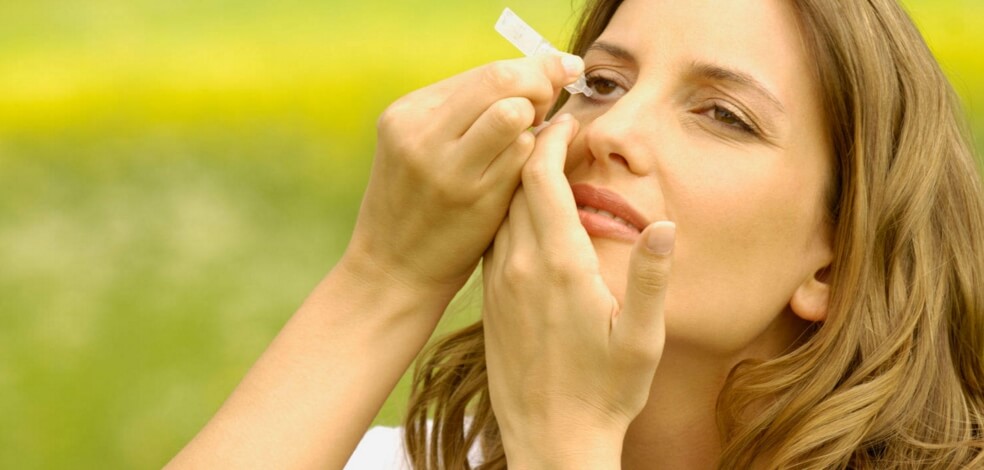
For the spring period, the manifestation of catarrh of the eyes is characteristic. Representatives of the strong half of humanity are more likely to suffer from this disease. The patient has severe eye itching and photophobia. And, of course, the most complex form of eye disease is eyelid fire swelling. The edema spreads within minutes, increases eye pressure and may damage the eyeball. Often occurs against the background of taking certain medications and food.
Antihistamine eye drops
Drops in the eyes from allergies with an antihistamine effect have a high speed even during periods of exacerbation. Reduce the amount of discharge from the eyes. The active substance of such drugs block the production and release of histamine and suppress the activity of allergens. Antihistamines create a kind of shell for the eyeball, which prevents the penetration of the allergen deep into. Such drops have practically no adverse reactions, therefore they are often recommended by doctors. Among them are the following:
| Olopatadin | The drug for the eyes in a short period of time relieves allergic manifestations of conjunctivitis, relieves itching and burning. Prolonged use of such drops should be monitored by a doctor, as it can cause "dry eye syndrome". |
| Azelastine | The effect of such therapy occurs already 10 minutes after application and lasts for 12 hours. Drops are contraindicated in case of pregnancy and in children under six years of age. |
| Opatanol | Eye drops are highly selective, so they do not affect other receptors. In children, it is allowed to use from the age of three. |
| Lecrolin | The drug stabilizes the membranes. Drops are actively used for prevention before the start of the allergy season. Remove redness and swelling of the mucous membrane of the eye. Not recommended for use by children under four years of age. |
| Ketotifen | These drops are dripped into the eyes up to two times a day with an interval of at least 8 hours. The drug is also used for purposes other than allergic eye diseases. Therefore, before using it, be sure to consult your doctor. |
Anti-inflammatory eye drops
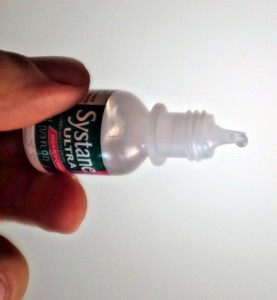 This type of drugs can be divided into hormonal and non-hormonal. These eye drops quickly relieve itching and severe swelling. But for long-term use, they are categorically contraindicated, as they are addictive, against which glaucoma develops, clouding of the lens. They are prescribed if during the test, in addition to the allergen, some infectious disease of the eye was also detected.
This type of drugs can be divided into hormonal and non-hormonal. These eye drops quickly relieve itching and severe swelling. But for long-term use, they are categorically contraindicated, as they are addictive, against which glaucoma develops, clouding of the lens. They are prescribed if during the test, in addition to the allergen, some infectious disease of the eye was also detected.
Hormonal anti-inflammatory eye drops include Sofradex, Tobradex, Lotoprednol and Dexamethasone. As for non-hormonal eye drops from this group, the following should be mentioned: Indocollir, Diclofenac, Diclo F. Such eye drops are very effective for Quincke's edema on the eyelids. In this case, they are prescribed for complex treatment along with the use of antihistamine tablets against allergies.
Vasoconstrictive eye drops
Vasoconstrictor drops relieve a large number of allergy symptoms, eliminate redness. If you use such drops for a long period of time, then addiction will definitely occur, and after cancellation, all manifestations will reappear. They are characterized by their rapid absorption through the eye vessels, penetrate into all body systems, which is not always a favorable condition. These drugs include:
| Naphthyzin | Both ophthalmic and nasal preparations are used. They can cause headache, nausea, insomnia. Contraindicated in glaucoma, cataracts, decreased secretion of the lacrimal gland. Children are allowed from the age of six. |
| Okumetil | Eye drops have anti-allergic and antiseptic effects. Removes swelling and irritation from the eyes. This drug against allergies has a number of contraindications: dry eye, glaucoma, epilepsy, asthma, problems in the cardiovascular system, pregnancy, diabetes, problems with the genitourinary system in both men and women. Children can use these drops from the age of two. |
| Octilia | The composition of the drug includes only natural ingredients. Used as a therapy for any eye disease. Among the contraindications are glaucoma, age up to three years and individual intolerance to some components. |
| Vizin | It is intended for the treatment of allergic conjunctivitis, as well as for chemical or physical effects on the shell of the eye from the side (dust, sand, powder, volatile vapors, etc.). Used by adults and children from the age of two. |
Rules for the use of eye drops
In order for the treatment of allergies with eye drops to be effective, and all signs disappear in a few minutes, it is important to learn how to properly carry out the eye instillation procedure. First of all, what should be noted is the thorough washing of hands using soap. Try to use a new pipette for each new drug. It is important that the pipette, when used, should not touch the eye itself. After each such procedure, try to rinse all materials with hot water and dry thoroughly.
- Before use, take a position so that it is convenient to tilt your head back;
- Pull the lower eyelid, while the eyes need to be rolled up;
- The required number of drops is instilled over the lower eyelid;
- Sit for five minutes after the procedure, while closing your eyes;
- The inner corners of the eyes can be massaged to spread the substance quickly.


